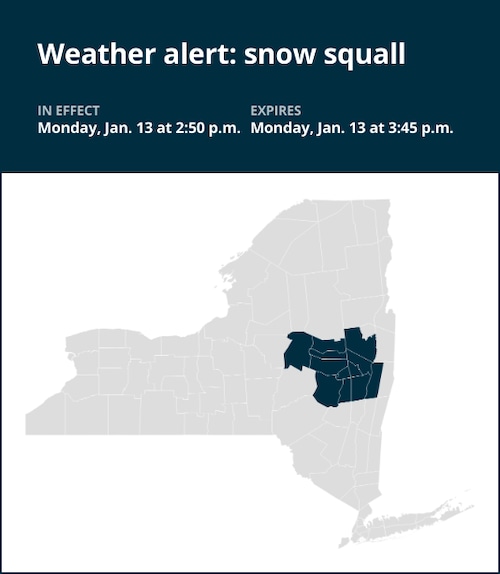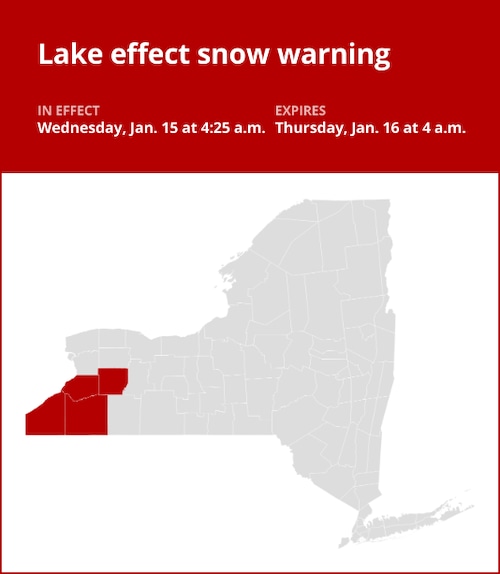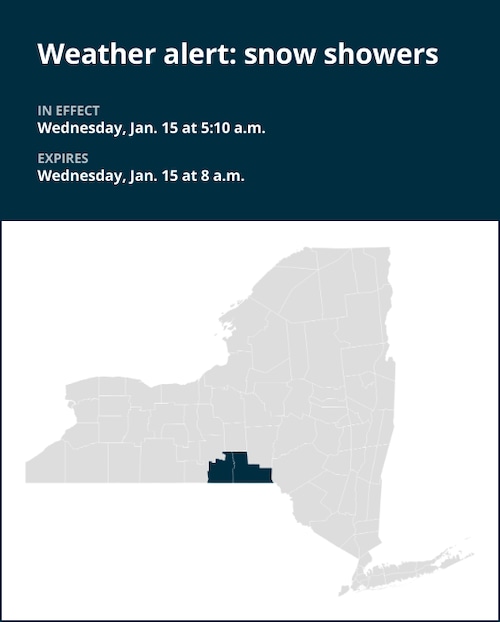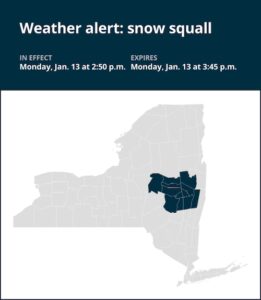At 2:50 p.m. on Monday, the National Weather Service issued a weather advisory for Herkimer, Fulton, Montgomery, Saratoga, Schoharie, Schenectady, Albany, and Rensselaer counties, warning of a snow squall that would last until 3:45 p.m.
“At 2:48 p.m., a snow squall was over Pattersonville-Rotterdam Junction, or near Scotia moving east at 25 MPH,” according to the weather service.
Cohoes, Gloversville, Watervliet, Johnstown, Colonie, Scotia, Mechanicville, Cobleskill, Canajoharie, Fonda, Latham, Jefferson, Guilderland, Albany, Schenectady, Troy, Clifton Park, Rotterdam, Saratoga Springs, and Amsterdam are among the places affected by the alert. The following roadways are included in this: Interstate 88 between exits 20 and 25. Between exits 5A and 29 on Interstate 90. Between exits 1a and 9 on Interstate 890. Exit 24 to exit 7 and exit 8A to exit 15 on Interstate 87. Between exits 8 and 9 on Interstate 787.
“If you have to travel into or through this squall, exercise extra caution,” the weather agency cautions. Accidents may result from sloppy roadways and abrupt changes in visibility. To get to your destination, slow down and give yourself more time.
Snow squalls: Risks, differences, and safety seasures
What are snow squalls?
Strong cold fronts are frequently linked to snow squalls, which are severe winter weather conditions. Even in the absence of a significant winter storm, they can swiftly cover roads with snow and ice. Even while these squalls usually last less than an hour and only produce light snow accumulation, their restricted visibility, strong winds, and quickly falling temperatures can make them dangerous. Unfortunately, in the past, these circumstances have played a role in catastrophic and occasionally fatal road accidents.
Understanding snow squalls vs. Snowstorms
A snowstorm and a snow squall differ primarily in their strength and length. Usually lasting 30 to 60 minutes, snow squalls are short yet fierce. A snowstorm, on the other hand, can last for several hours or even days.
Snow squall warnings
Similar to tornado and severe thunderstorm warnings, snow squall alerts are short-fused and targeted at specific locations. These alerts offer vital, extremely targeted information that can save lives. If your neighborhood is under a snow squall warning, stay indoors or postpone driving until the squall has passed.
Actions during a snow squall warning
When a snow squall warning is issued, people should heed the weather service’s instructions, which include the following crucial steps:
Avoid or postpone travel: If your area is under a snow squall warning, stay indoors or wait for the squall to pass through before driving. During a snowstorm, there is absolutely nowhere safe to drive on the roadway.
Reduce speed and improve visibility: If you’re already on the road during a snowstorm, put safety first by slowing down. To improve visibility for other vehicles and yourself, turn on your danger lights in addition to your headlights.
Keep a safe distance by giving the automobile in front of you plenty of space.
Steer clear of sudden braking: It’s also best to avoid applying the brakes too hard. This could lead to a loss of vehicle control and raise the possibility of a chain reaction collision on slick or icy roads.
Winter weather safety advice: Go to the weather service’s Winter Weather Safety page for advice on how to be safe before, during, and after a winter storm.
Make sure your car is ready for winter driving by checking the tires, brakes, lights, and making sure all the fluids are at the right levels before you go. A well-maintained car is better equipped to handle the challenges of winter driving.
Essentials for an emergency kit: Always keep a fully stocked emergency bag in your car with essentials like water, non-perishable food, blankets, a flashlight, and a first aid kit. For better tire traction, add jumper cables, flares or a reflective triangle, ice scraper, a map, a car cell phone charger, and cat litter or sand. Should you experience an emergency or unplanned breakdown while traveling, these supplies can be quite helpful.
In conclusion, putting one’s own safety first and following the weather service’s advice can greatly reduce dangers when a snow squall warning is in effect. People can travel through these winter dangers with more assurance and security if they are aware of them, plan beforehand, and remain alert.
United Robots offers a service called Advance Local Weather Alerts that gathers the most recent information from the National Weather Service using machine learning.







+ There are no comments
Add yours